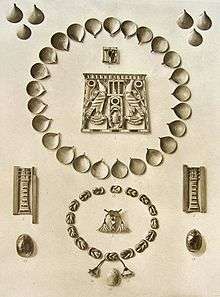Knot (hieroglyph)
| ||
| Knot in hieroglyphs |
|---|

The ancient Egyptian knot hieroglyph, or girdle knot, Gardiner sign listed no. S24, portrays a reef knot. Besides its use as a hieroglyph, it has usage in statuary and reliefs. The knot hieroglyph is also an amulet, typically made of worked stone, or as jewellery elements.[1]
Language usage
The knot hieroglyph is used in the Egyptian language as the verb, (th)s, (th)ss, for to knot, to tie, to tie together, etc.
|
It is used as the phonogram for (th)s, as well as the determinative. There are many alternate spellings.
For the noun, it is Egyptian language (th)s, (th)s.t,
|
for meanings of: knot, tie, ligature, backbone, vertebrae, spine, etc.
In jewellery and decoration
The knot used as an article of jewellery was especially known in the Middle Kingdom. It can be found in necklaces (see gallery photo), and as a small brooch. In Amulets of Ancient Egypt, a two-part, hollow gold piece is shown, with a detailed rope-detailed fiber; it is made with a tongue and groove closure for the parts.[2]
Preceded by
to glitter -- -- (th)hn |
knot -- -- (th)s |
Succeeded by
to lift up -- -- (th)sy |
Gallery
- Funerary cone using the 'girdle-knot hieroglyph'
 Small bandlet made of 16 knot-pieces
Small bandlet made of 16 knot-pieces- Relief from reign of Hatshepsut
See also
| Wikimedia Commons has media related to Belt knot (hieroglyph). |
| Wikimedia Commons has media related to |
References
- Andrews, Carol, 1994. Amulets of Ancient Egypt, chapter 4: Scarabs for the living and funerary scarabs, pp 50–59, Andrews, Carol, c 1993, University of Texas Press, 518 amulets, 1, or multiples included in 12 necklaces; (softcover, ISBN 0-292-70464-X)
- Budge. An Egyptian Hieroglyphic Dictionary, E.A.Wallace Budge, (Dover Publications), c 1978, (c 1920), Dover edition, 1978. (In two volumes, 1314 pp, and cliv-(154) pp.) (softcover, ISBN 0-486-23615-3)